Table of contents
- Concept comparison: tricycles Urgent Trinity
- Brudeli Leanster 654L
- Piaggio MP3 400 LT
- Ruko B-King team
- Ruko RX
- Can-Am Spyder Roadster
- MOTORCYCLE measurements
- MOTORCYCLE conclusion

Bilski
motorcycles
Concept comparison: tricycles
Concept comparison: tricycles
Urgent Trinity
Three bikes are one too many for some bikers. MOTORRAD has tested five concepts to see whether this old prejudice is still valid. Or whether innovative three-wheeler solutions are now just as much fun as the classic two-wheeler.
Rolf Henniges
09/10/2009
So where does the single-track vehicle end the motorcycle and where does the car begin? With two or four wheels, the matter is clear, with three wheels, even experts find it difficult to differentiate between them. Even the legislature has its difficulties here. Four of the five tricycles tested here are allowed to be driven with a car driver’s license, namely precisely those with two wheels on the front axle: every car driver is allowed to drive Piaggio MP3 400 LT, Can-Am Spyder Roadster SE5, Brudeli Leanster or the bizarre self-made RX from the company Ruko pilot. The motorcycle license is only compulsory for the classic Ruko team based on the Suzuki-B-King. The lane width, which must be at least 460 millimeters, is decisive for the car driver’s license so that the scooter complies with the EC directive for three-wheeled vehicles. A curious legal situation that raises questions. These vehicles actually behave so foolproof that you can easily control them without two-wheeler experience?
Buy complete article
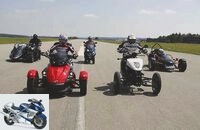
Concept comparison: tricycles
Urgent Trinity
10 pages) as PDF
€ 2.00
Buy now

Bilski
Piaggio MP3 LT.
And how do they ride compared to a motorcycle? Does the third wheel still act as a brake on fun for bikers? To find out, the five concepts had to prove themselves not only in everyday life, but also in driving dynamics tests on the pylon course. Brudeli Leanster 654L a Norwegian designer builds the tricycle based on a KTM 690 SM. Thanks to a sophisticated suspension, the front wheels can be tilted, so the chassis can be tilted like a motorcycle. The inclination can be limited in four stages up to a maximum of 45 degrees.
The tight damping of the two front suspension struts ensures that the front wheels are guided smoothly on the ground and do not jump with every small bump in the ground. When driving, however, steering feels like a steering head bearing is too tight. This is annoying, especially at low speeds. The 690 KTM single seems a bit overwhelmed with its 236 kilograms and always craves speeds above 5000.

Bilski
The Ruko RX.
Most difficult exercise with the Leanster: slalom driving at walking pace. This contradicts the engine characteristics of the single. And it’s a tough balancing act due to the sluggish front suspension. The Leanster feels much more comfortable at speed. Entering a corner: The first steering impulse comes from the handlebars, then physical effort is required, as is the case with a motorcycle. The feet rest on the pegs (there are also running boards for off-road use, which always remain horizontal regardless of the incline), with the upper body you can fully hang in. Roundabouts have seldom been more welcome than on the Leanster. An experienced biker needs at least half a day to get used to the sluggish (self) steering behavior. Also because of the track width of 1.10 meters, you quickly end up with a wheel on the opposite lane. Correcting course or changing lean angles require enormous concentration and practice. You don’t need to waste a lot of words about suitability for everyday use: 7.5 liter tank capacity, hard vibrations, take your luggage with you, forget it. But you are king on the promenade.
For those who drive behind, the show is awesome. Ruko B-King team Hand on heart: When was the last time you drove a team? Forget all the memories of the poorly screwed-on sidecars of yesteryear. Special chassis with stub axle steering turn today’s sidecars into state-of-the-art designs. The Swabian noble forge Ruko proves this with the team based on the Suzuki B-King. Steering and suspension work independently of each other. The vehicle and wheel geometry can be set between ultra-handy and extremely stable. Curve robbers become a fascinating experience. Although the sidecar still lifts slightly in very fast right-hand bends, the vehicle remains controllable. In left turns it is stable, the self-steering behavior remains good-natured and predictable. Ruko boss Jorg Schlittenhardt has given the B-King a shapely Bodis rear silencer. In addition, the machine has a shorter gear ratio thanks to a larger sprocket in conjunction with the smaller 15-inch rear wheel. Result: Despite a total weight of 450 kilograms, the nominal 184 hp four-cylinder whirls the mass around the pylons almost like a toy. There is no ABS, but the braking effect can be distributed to the three internally ventilated disc brakes via a control valve, depending on the load.
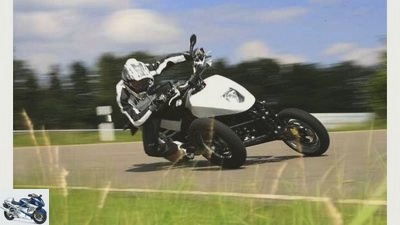
Bilski
Brudeli Leanster 654L.
In the event of extreme braking, the combination remains stable on the track. For the two, pardon: three-wheel-enthusiastic head of the family, the team is the clear winner of the comparison. Can-Am Spyder Roadster the new trend? According to unconfirmed rumors, 50,000 units are produced per year. In the USA the Spyder is not uncommon, here it is still watched like an alien. The Canadian group BRP presented its three-wheeler concept back in 2006. The company Sixmonkeys from Freudenberg also believes in the success of the Spyder and has developed a special sports suspension. No fewer than six electronic systems monitor every driving situation and guarantee safe driving pleasure. With the Spyder you can neither roll over, nor can the machine slide through curves with the rear wheel breaking away and spinning. Although the 106 hp could be expected to do that. The 60-degree V-engine comes from the shelf of the Austrian Rotax forge, which also belongs to BRP, and was originally developed for the Aprilia RSV Mille super sports car. The test vehicle was equipped with a sequential electronic transmission. The gears are changed using a switch next to the left handle. When braking, for example at a traffic light, the transmission shifts down automatically. It works so well that one naturally wonders when this system will find its way into motorcycle construction. Can-Am’s Spyder Roadster is probably the three-wheeler in the test with which motorists inexperienced two-wheelers can get along the fastest. And like the Ruko RX, it has the least to do with motorcycles. If nothing else, of course, because the structure cannot be tilted. The brakes are also reminiscent of a car: the vehicle is only decelerated using a foot pedal that activates an integral brake system with ABS.
The relatively high steering forces take getting used to and train the upper body. Less sporty drivers will break out in a sweat of fear at the first roundabout. Nevertheless, the Spyder combines a driving feeling with active safety and can best be described as a combination of a convertible and a sporty touring motorcycle. A handicap: because the vehicle does not lean, the driver and front passenger have to fully compensate for the lateral acceleration forces. While the pilot can lean on the handlebars, only the handles are available to the pillion passenger. No problem with leisurely cruising. However, if you are really committed to it, you need an equally sporty co-driver. Piaggio MP3 LT. Unlike the rigid Spyder, the three-wheel scooter is a swivel. The Italians advertise more stability and security compared to the single-track scooter. When looking at the parallelogram front suspension and the two front wheels, one first thinks of the advantage of not being able to fall over at traffic lights. That’s right, a switch can be used to block the tilting of the front wheels at speeds below ten km / h in push mode. As soon as you accelerate again, the blockage is released. The suspension allows a maximum incline of 40 degrees in curves. Anyone who initially brakes again shortly after starting off and trusts the blockage can tip over. That sounds like getting used to, but it can be learned quickly. After a short period of familiarization, the three-wheel scooter is extremely easy to drive for a motorcyclist. It tilts slightly, the second wheel can only be felt through a certain inertia around the steering axis. The larger contact surface of the two front wheels gives more grip in the border area. It is difficult to feel it, however, as there is no feedback. The chassis bumps over bumps, the wheels jump. Therefore, you don’t want to go far in an inclined position, especially on uneven ground. Effective braking is also difficult under these circumstances, because the locking limit of the front wheels remains diffuse.
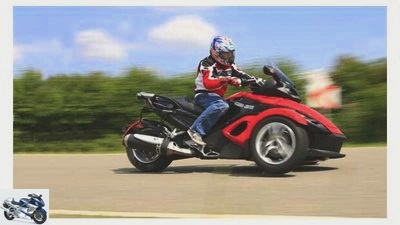
Bilski
Can-Am Sypder Roadster SES.
An ABS would be extremely helpful. The brakes are actuated via a hand lever (front right, rear left) and a foot pedal, which activates the stoppers at the front and rear at the same time. Away from the sporty limits, for example when shopping, cruising in the city or strolling overland, the Piaggio leaves a good impression and is hardly inferior to the handling of large scooters. Ruko RX takes a completely different approach. This vehicle is closer to the car than any other, as the low seat position suggests. The engine, however, donated a two-wheeler, namely a Honda CBR 1100 XX.
The Porsche steering gear, Golf III steering column and OZ aluminum rims come from the car. Most of it, however, comes from the parts racks for carriage production, various bending machines and, above all, from the mind of 45-year-old Ruko designer Rainer Rothweiler. Using the unique RX, the Swabian team builders demonstrate how to spend long winter evenings sensibly. The RX has TuV approval and drives as hard and direct as a huge kart. You float in the bucket seat just 22 centimeters above the ground, the throttle response is soft, the completely rebuilt gearshift direct, the steering razor-sharp and precise. However, there are still coordination problems with the clutch: it is difficult for the foot to dose the actuation originally intended for the manual clutch. Five completely different interpretations on the subject of tricycles, which are geared towards either a motorcycle or a car. What they all have in common is that it is primarily about having fun: new experiences, unprecedented dynamics, fresh concepts and unusual designs and, last but not least, driving. But when you buy it, the fun comes to an abrupt end, the tricycles are either expensive (Piaggio MP3), extremely expensive (Can-Am Spyder and Brudeli Leanster) or simply unaffordable.
Brudeli Leanster 654L
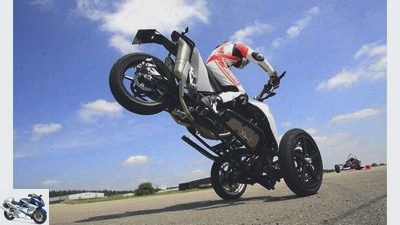
Bilski
3 wheel stoppie.
Number of cylinders: 1
Displacement: 654 cm3
Rated output 64 hp at 7500 rpm
Max. Torque: 65 Nm at 6550 rpm
Gears: 6
Front tire: 120/70 ZR 17
Rear tire: 160/60 ZR 17
Wheelbase: 1510 mm
Track width. 1100 mm
Length x width x height 2120 x 1290 x 1400 mm
Seat height: 860 mm
Turning circle: 8950 mm
Weight with a full tank: 236 kg
Tank capacity approx. 7.5 l
Consumption: 4.5 l
Range: 167 km
Top speed: * 170 km / h Driving license class B (car)
Price: 23,000 euros
Thanks to the company Sixmonkeys, which provided the Brudeli Leanster. Info: www.sixmonkeys.de and www.brudelitech.com * Manufacturer information
Piaggio MP3 400 LT
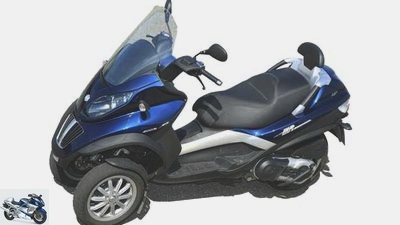
Bilski
Piaggio MP3 400 LT.
Number of cylinders: 1
Displacement: 399 cm3
Rated power: 33 hp at 7250 rpm
Max. Torque: 38 Nm at 5250 rpm
Gears: automatic
Front tire: 120 / 70-12
Rear tire: 140 / 70-14
Wheelbase: 1550 mm
Track width: 465 mm
Length x width x height 2210 x 760 x 1350 mm
Seat height: 800 mm
Turning circle: 6150 mm
Weight with a full tank 265 kg
Tank capacity 12 l
Consumption: 3.8 l
Range: 316 km
Top speed *: 140 km / h
Driving license class: B (car)
Price: 7,999 euros
The MP3 LT is optionally available with a 250cc single-cylinder four-stroke engine for 6,999 euros. Info: www.de.piaggio.com
* Manufacturer information
Ruko B-King team
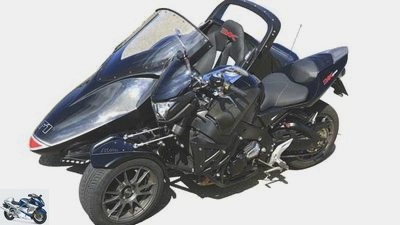
Bilski
Ruko B-King team
Number of cylinders: 4
Displacement: 1340 cm3
Rated output: 184 hp at 9500 rpm
Max. Torque: 146 Nm at 7200 rpm
Gears: 6
Front tire: 195 / 50-15
Rear tire: 195 / 50-15
Wheelbase: 1700 mm
Track width: 1375 mm
Length x width x height 2280 x 1900 x 1150 mm
Seat height: 780 mm
Turning circle: 10300 mm
Weight with a full tank 450 kg
Tank capacity approx. 36 l
Consumption: 9.0 l
Range: 400 km
Top speed *: 205 km / h
Driving license class: A1 (motorcycle)
Price: approx. 48,000 euros **
The cheapest combination conversion of a B-King starts at Ruko from 18,000 euros, depending on the equipment. Info: www.ruko-fahrzeugtechnik.de * manufacturer information; ** including new vehicle Suzuki B-King
Ruko RX
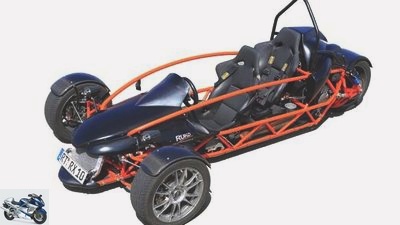
Bilski
Ruko RX
Number of cylinders: 4
Displacement: 1137 cm3
Rated power: 152 hp at 9000 rpm
Max. Torque: 119 Nm at 7300 rpm
Gears: 6 forward / 1 backward
Front tire: 225 / 45-17
Rear tire: 275 / 35-18
Wheelbase: 2860 mm
Track width: 1518 mm
Length x width x height 3680 x 1800 x 1380 mm
Seat height: 220 mm
Turning circle: 10900 mm
Weight with a full tank: 520 kg
Tank capacity approx. 40 l
Consumption: 8.0 l
Range: 500 km
Top speed *: 207 km / h
Driving license class: B (car)
Price: from 55,000 euros **
The RX is currently a one-off approved for road traffic. If interested, the Ruko team would build more tricycles of this type * Manufacturer information; ** The engine, exhaust system, wiring harness and control unit must be delivered
Can-Am Spyder Roadster

Bilski
Can-Am Spyder Roadster
Number of cylinders: 2
Displacement: 998 cm3
Rated output: 106 hp at 8500 rpm
Max. Torque: 104 Nm at 6250 rpm
Gears: 5 gear forward / 1 gear back
Front tires: 165/65 R14
Rear tire: 225/50 R15
Wheelbase: 1727 mm
Track width: 1308 mm
Length x width x height 2667 x 1506 x 1145 mm
Seat height: 770 mm
Turning circle: 9600 mm
Weight with a full tank 387 kg
Tank capacity: 25 l
Consumption. 7.5 l
Range: 333 km
Top speed *: 180 km / h
Driving license class: B (car)
Price: from 17299 euros
The Spyder is also optionally available with a five-speed gearbox operated by a foot lever. Info: www.spyder.brp.com/DE-de * Manufacturer information
MOTORCYCLE measurements

BILLION
MOTORCYCLE conclusion

Bilski
The MOTORRAD conclusion of the five tricycles.
Ruko B-King team:
The surprise from the Swabian town of Metzingen: dynamic, stable, precise and easy to steer, with a lot of power. Compared to the other three-wheeler concepts, the B-King team offers the most, but above all, two-wheel-like driving fun for die-hard bikers. The course values are almost identical to those of the Can-Am, the larger turning circle prevents better times. Particularly impressive: the workmanship, comfort and equipment of the dinghy.
Can-Am Spyder:
No question about it: A Spyder without safety-relevant control systems would be hard to beat on a curve or pylon course. The constantly regulating traction and stability control systems prevent top values in slalom, but also ensure that you don’t roll over in fast corners. The Spyder is incomparable. His concept is far removed from a car, motorcycle or team and can best be described as a sporty snowmobile for the road.
Piaggio MP3:
400 LT The enlarged track width (LT = large treat) ensures that the narrow tricycle can be driven with a car driver’s license. The construction is foolproof and easy to drive, only the locking system when stationary takes getting used to. Except for the rather weak 400 engine and a lack of ABS, there is hardly a shortcoming. The MP3 is the easiest tricycle to master in this comparison. Nevertheless: Without any two-wheeler experience, it will be difficult for drivers.
Brudeli Leanster:
A vehicle for self-confessed individualists. Not easy to control, here vehicle control is equal to competitive sport. The Leanster is a challenge for experts and an ideal toy for those who already have everything in their garage. Despite the not particularly powerful 690 single, the Norwegian one-of-a-kind flies the fastest through the course. With other tires, the sporty tricycle can also be used off-road.
Ruko RX:
From a “Beer mat idea” the RX was built in 18 months. And it works. The clutch, however, requires a lot of tip-toe feeling, this fact prevented even better times on the slalom course. The risk of a rollover is great without stability programs. For the time being a one-of-a-kind piece, but not categorically excluded. The driving pleasure is huge, the lateral acceleration can only be compared to a kart.
Related articles
-
Concept comparison: muscle bikes
motorcycles Concept comparison: muscle bikes Concept comparison: muscle bikes Night on Content of While the protagonists in Jim Jarmusch’s Taxler epic…
-
Concept comparison: Kawasaki, Triumph, Yamaha
K motorcycles Concept comparison: Kawasaki, Triumph, Yamaha Concept comparison: Kawasaki, Triumph, Yamaha Fabric for Zoff Content of The liter is a handy…
-
Concept comparison: Honda Fireblade, KTM 990 Super Duke R, Suzuki GSX-R 600, Yamaha FZ6
Gargolov motorcycles Concept comparison: Honda Fireblade, KTM 990 Super Duke R, Suzuki GSX-R 600, Yamaha FZ6 Concept comparison: Honda Fireblade, KTM 990…
-
Concept comparison of supermotos
fact motorcycles Concept comparison of supermotos Supermotos from Aprilia, BMW, Ducati, KTM and Yamaha Lean angle, cornering speed and lap times No…
-
Concept comparison of enduro vs. off-road tires
Markus Jahn 14th pictures Markus Jahn 1/14 Is every rough hunter an off-roader? How many off-road genes are there in typical enduro tires? In the third…
-
Comparison test: Suzuki Hayabusa old against new
motorcycles Comparison test: Suzuki Hayabusa old against new Comparison test: Suzuki Hayabusa old against new Shoot out boys! Content of Hayabusa, the…
-
Accessory wheel sets in comparison
mps photo studio accesories tire Accessory wheel sets in comparison Comparative test of accessory wheels Accessory wheels in the test Content of Lighter…
-
Comparison test: Honda Hornet, Kawasaki Z 750, Suzuki GSR 600
Jahn motorcycles Comparison test: Honda Hornet, Kawasaki Z 750, Suzuki GSR 600 Comparison test: Honda Hornet, Kawasaki Z 750, Suzuki GSR 600 ABS shooters…
-
Comparison test BMW K 1300 R, Buell 1125 CR, Suzuki B-King, Yamaha Vmax
K 37 pictures Yamaha 1/37 First look at the device from all sides… Yamaha 2/37 Yamaha 3/37 Yamaha 4/37 Yamaha 5/37 Yamaha 6/37 Yamaha 7/37 What is…
-
Comparison test: 600s in a quintet
Jahn motorcycles Comparison test: 600s in a quintet Comparison test: 600s in a quintet Toys Content of The middle class is burning brightly! The…